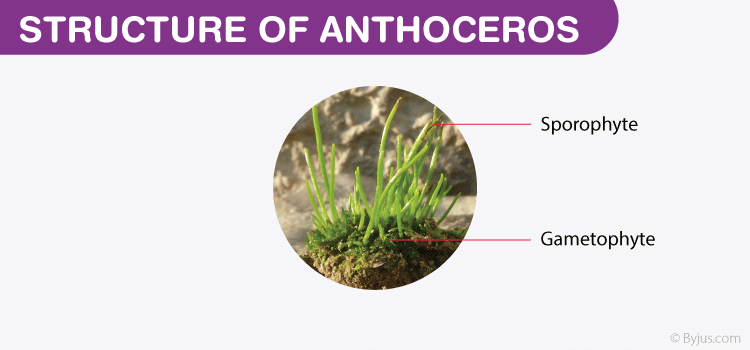Hornworts are bryophytes that constitute the division Antherocerotophyta. They are horn-like structures that are widely found in humid, damp and shady areas. Anthoceros, Dendroceros, Megaceros, Nothoceros and Folioceros are some notable genera under Hornworts.Also, there are approximately 300 species of known hornworts.
They have a flat body without much internal differentiation. Their sex organs are dorsally embedded in their thallus. Also, they have root-like structures called rhizoids. These rhizoids are smooth-walled structures.
Characteristic Features of Hornwort
- The main plant body is thallus-like and lacks true roots, stem and leaves. Its flattened body is haploid and produces gametes. Thus, it is known as a gametophyte.
- Each thallus consists of a chloroplast that aids in the photosynthesis process.
- Most hornworts have a unique feature called pyrenoids. It helps in the fixation of photosynthetic carbon.
- Hornworts produce multicellular structures called sporophytes. These structures get attached to the photosynthetic gametophyte and derive nutrition from them.
- Most of the hornworts have true stomata on their sporophyte.
Reproduction
- Sexual Reproduction – Antheridium is the male sex organ, and archegonium is the female sex organ. In the water body, the male (antherozoids) and female gametes (egg) come in contact with each other to form a zygote. The zygote undergoes division to form sporophytes.
- Asexual Reproduction – Vegetative propagation like tubers and fragmentation are seen. The thallus fragments and forms a new plant body under favourable conditions.
Also Refer: Asexual Reproduction in Plants

Bryophytes
Bryophytes include hornworts, liverworts and mosses. They are commonly found in moist and shady areas. Their plant body is a bit more differentiated than algae. It is usually a thallus-like structure that is attached to the substratum by rhizoids. They reproduce through spores.
Explore: Differences between Liverworts and Mosses
Frequently Asked Questions
Why are bryophytes called amphibians of the plant kingdom?
What are the uses of bryophytes?
Usually, bryophytes do not have much economic importance. Some mosses serve as food for herbaceous animals. The peat of sphagnum moss is used as fuel. Also, bryophytes form a thick layer on the soil, preventing soil erosion. They decompose rocks by secreting acidic substances, and also make substrates for the growth of higher plants.
What is hornwort used for?
Hornworts serve as good aquarium plants. They carry photosynthesis and provide oxygen to the fishes. They also act as a site for breeding. The fish can hide their fry on the tiny leaves of hornworts. Moreover, hornworts also absorb waste components like nitrates, phosphates and ammonia in an aquarium.
Also Read: Bryophytes
Keep exploring BYJU’S Biology for more exciting topics.
Comments